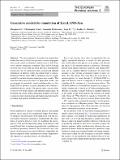Generative models for simulation of KamLAND-Zen
Author(s)
Fu, Zhenghao; Grant, Christopher; Krawiec, Dominika M.; Li, Aobo; Winslow, Lindley A.
Download10052_2024_Article_12980.pdf (1.559Mb)
Publisher with Creative Commons License
Publisher with Creative Commons License
Creative Commons Attribution
Terms of use
Metadata
Show full item recordAbstract
The next generation of searches for neutrinoless double beta decay (0𝜈𝛽𝛽
) are poised to answer deep questions on the nature of neutrinos and the source of the Universe’s matter–antimatter asymmetry. They will be looking for event rates of less than one event per ton of instrumented isotope per year. To claim discovery, accurate and efficient simulations of detector events that mimic 0𝜈𝛽𝛽
is critical. Traditional Monte Carlo (MC) simulations can be supplemented by machine-learning-based generative models. This work describes the performance of generative models that we designed for monolithic liquid scintillator detectors like KamLAND to produce accurate simulation data without a predefined physics model. We present their current ability to recover low-level features and perform interpolation. In the future, the results of these generative models can be used to improve event classification and background rejection by providing high-quality abundant generated data.
Date issued
2024-06-27Department
Massachusetts Institute of Technology. Laboratory for Nuclear ScienceJournal
The European Physical Journal C
Publisher
Springer Science and Business Media LLC
Citation
Fu, Z., Grant, C., Krawiec, D.M. et al. Generative models for simulation of KamLAND-Zen. Eur. Phys. J. C 84, 651 (2024).
Version: Final published version
ISSN
1434-6052